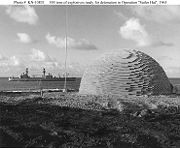
Operation Sailor Hat
Encyclopedia

United States Navy
The United States Navy is the naval warfare service branch of the United States Armed Forces and one of the seven uniformed services of the United States. The U.S. Navy is the largest in the world; its battle fleet tonnage is greater than that of the next 13 largest navies combined. The U.S...
on the island of Kahoolawe
Kahoolawe
Kahoolawe is the smallest of the eight main volcanic islands in the Hawaiian Islands. Kahoolawe is located about seven miles southwest of Maui and also southeast of Lanai, and it is long by wide, with a total land area of . The highest point on Kahoolawe is the crater of Lua Makika at the...
, Hawaii
Hawaii
Hawaii is the newest of the 50 U.S. states , and is the only U.S. state made up entirely of islands. It is the northernmost island group in Polynesia, occupying most of an archipelago in the central Pacific Ocean, southwest of the continental United States, southeast of Japan, and northeast of...
in 1965. As they were not nuclear tests, they instead employed conventional explosives (i.e. TNT) to simulate the effects of a nuclear weapon
Nuclear weapon
A nuclear weapon is an explosive device that derives its destructive force from nuclear reactions, either fission or a combination of fission and fusion. Both reactions release vast quantities of energy from relatively small amounts of matter. The first fission bomb test released the same amount...
blast. The purpose of these three tests was to study the effects of shock and blast of a nuclear explosion on naval vessels. In addition, seismological
Seismology
Seismology is the scientific study of earthquakes and the propagation of elastic waves through the Earth or through other planet-like bodies. The field also includes studies of earthquake effects, such as tsunamis as well as diverse seismic sources such as volcanic, tectonic, oceanic,...
data, underwater acoustics
Underwater acoustics
Underwater acoustics is the study of the propagation of sound in water and the interaction of the mechanical waves that constitute sound with the water and its boundaries. The water may be in the ocean, a lake or a tank. Typical frequencies associated with underwater acoustics are between 10 Hz and...
, radio communications, cratering, air blast
Atmospheric focusing
Atmospheric focusing is a phenomenon occurring when a large shock wave is produced in the atmosphere, as in a nuclear explosion or large extraterrestrial object impact. The shock wave is refracted horizontally by density variations in the atmosphere so that it can have impacts in localized areas...
effects, cloud growth, fire ball generation, and electromagnetic data were gathered. The former light cruisers and , the guided-missile destroyers , , , , and the Canadian Navy's escort destroyer all participated in the trial.
Each "Sailor Hat" test consisted of a dome stacked 500-ton charge of TNT high explosive detonated
Detonation
Detonation involves a supersonic exothermic front accelerating through a medium that eventually drives a shock front propagating directly in front of it. Detonations are observed in both conventional solid and liquid explosives, as well as in reactive gases...
on the shore of Kahoolawe close to the ships under test and each test saw the USS Atlanta move closer to the explosion. The first test, called Bravo, occurred on 6 February and the second test, called Charlie, occurred on 16 April 1965. The last was codenamed Delta and occurred on 19 June 1965.

